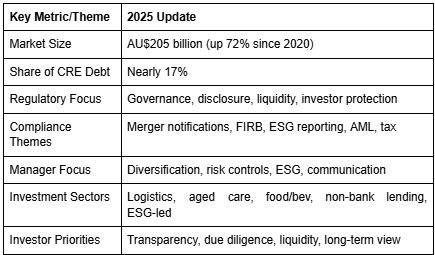Quick Links
Australia’s private credit market is at a crossroads. Just a few years ago, it was a space for institutional specialists, but today, private credit represents a major pillar of the nation’s financial system. Assets under management have doubled since 2020, reaching around AU$205 billion in 2025 and now cover nearly one-fifth of commercial real estate debt in the country. While the rapid rise reflects strong demand from borrowers and investors alike, it has also triggered a fundamental rethink of risk, transparency, and market discipline.
The Rise—and Reassessment—of Private Credit
The rapid growth of private credit is a story of opportunity and adaptation. As banks tightened lending standards and economic volatility increased, private credit funds stepped in to fill the gap, offering tailored solutions and quicker decisions to businesses across sectors. This influx of capital gave companies alternatives to traditional bank debt and created new ways for investors to earn income outside the public bond market.
But this expansion brought with it a more complex web of risks. Many new vehicles promise investors the ability to trade in and out daily, yet the loans and investments backing these products are fundamentally illiquid. The result is a market where perceived liquidity does not always match reality, especially in times of stress. In the background, defaults and high-profile workouts have started to test both investors and fund managers, highlighting the importance of rigorous risk management and realistic expectations.
Regulatory Scrutiny: Raising the Bar for Everyone
With so much capital at stake, Australia’s regulators have turned their focus squarely onto private credit. This year saw a wave of new actions and proposals: surveys were sent to funds to assess their governance, disclosure practices, and how they manage conflicts of interest. The objective is clear—regulators want to ensure that the fast pace of growth does not outstrip the standards needed to protect investors and financial stability.
This scrutiny goes beyond the structure of private credit products themselves. The channels used to market these funds, particularly to high-net-worth and retail investors, are under review. There is a rising concern that some investors may not fully grasp the real risks—such as the leverage embedded in products or the potential for asset values to become stale and disconnected from market reality.
Efforts are now underway to tighten disclosure standards, clarify fee structures, and demand more regular, accurate reporting of asset values and portfolio holdings. As private credit becomes more mainstream, it is being held to a higher standard of governance—one that matches its growing influence in the Australian market.
Default, Downside, and the Realities of Private Credit
A defining feature of private credit is the way professionals manage risk. This is a field where thinking about worst-case scenarios is not a side note, but a core discipline. When market volatility increases or specific borrowers hit headwinds, lenders must be prepared for situations ranging from refinancing and restructuring to, in rare cases, stepping in to take ownership or control to protect capital.
Recent market events have shown that even well-constructed deals can face stress in unpredictable economic conditions. The best managers do not assume everything will run smoothly. Instead, they continuously assess portfolio risk, stay close to borrowers, and maintain enough diversification to manage surprises.
Diversification is not just a buzzword in today’s environment. The top funds are building portfolios that include direct lending, asset-backed lending, structured credit, and investment-grade private placements. This breadth allows them to pivot—adjusting exposure as some sectors become riskier and others more attractive. For many, this is now an essential part of surviving the credit cycle.
The Expanding Rulebook: Major Reforms and What They Mean
The last year has seen Australia’s regulatory landscape shift rapidly for private credit and private capital more broadly. Several headline reforms are set to shape the next phase of growth:
1. Mergers and Competition Law
Mandatory notification of large mergers means that private credit-backed roll-up strategies and acquisition funding will face more checks, documentation, and regulatory costs. This adds time and complexity to deal execution, and parties need to start planning early to avoid delays.
2. Foreign Investment and Housing
New rules on foreign ownership and a streamlined—but tougher—approval process reflect a national focus on housing affordability and strategic assets. Investors and their advisors must now navigate higher application fees, greater information requests, and stricter scrutiny for deals in sensitive sectors.
3. ESG and Climate Reporting
Mandatory climate and sustainability reporting now applies to thousands of large Australian companies, including many portfolio companies within private credit funds. Investment managers are expected to go beyond financial analysis and evaluate environmental and governance risks with the same rigor as credit risk. This is already changing which deals get funded and which are left behind.
4. Cybersecurity, Privacy, and Data
Recent enforcement actions have reinforced the need for robust data protection and cyber-resilience. New laws and penalties mean that even minor lapses can be costly and damage reputation. Private funds must have strong systems, not just to satisfy compliance, but to meet investor expectations.
5. Tax and Anti-Money Laundering
Tax authorities are targeting large private groups with new programs focused on governance and risk profiling. Meanwhile, AML and counter-terrorism reforms are expanding the pool of regulated entities and tightening documentation standards, making compliance an even greater operational challenge.
Investment Strategy: Surviving and Thriving in a Mature Market
The combination of regulatory pressure and market complexity is fundamentally changing how private credit funds operate. Successful managers today are:
- Building resilient, diversified portfolios that can withstand shocks and rotate capital to stronger sectors as needed.
- Prioritizing transparency and robust disclosure, ensuring that investors have a clear view into fees, leverage, and real risks.
- Engaging with ESG and climate risk as a core investment screen, not an afterthought.
- Communicating clearly with clients about changing risk profiles and the reality of potential downside, even if it means tempering return expectations.
- Preparing for greater oversight by regulators, auditors, and investors, with systems and documentation to match.
Opportunities remain, particularly in sectors like logistics, aged care, food and beverage, and non-bank lending platforms, which are well-placed to benefit from demographic shifts and supply chain changes. However, the bar for risk assessment and due diligence has never been higher.
Lessons for Investors: Discipline Over Hype
For investors—whether institutions, family offices, or individuals—the private credit boom still offers real potential, but the discipline needed is much greater than in the past. Chasing high yields without understanding the full risk profile, liquidity terms, or the manager’s approach to governance is a recipe for disappointment.
Investors should focus on managers with a proven ability to navigate volatile cycles, real experience across credit markets, and a culture of openness around risk, fees, and governance. Diversification, patience, and a clear-eyed view of liquidity are crucial. In a sector where surprises are inevitable, preparation and resilience are what separate long-term winners from those left exposed in a downturn.
The Next Chapter: From Boom to Sustainable Scale
Australia’s private credit market has quickly become one of the most dynamic and important sectors in the financial system. But with size comes responsibility. The days of rapid, unchecked growth are ending, replaced by an era defined by higher standards, better oversight, and deeper discipline at every level.
For fund managers, this means doing the hard work—broadening portfolios, deepening due diligence, strengthening governance, and engaging with new compliance realities. For investors, it means asking sharper questions, seeking transparency, and resisting the urge to chase returns without understanding the underlying risk.
If the lessons of the past few years are taken seriously, Australia’s private credit market can continue to thrive—not just in scale, but in quality, resilience, and its ability to deliver real value to the broader economy.
Summary Table: Australia’s Private Credit in 2025

Australia’s private credit market is entering a new phase. The opportunity is real—but only for those willing to do the work, embrace transparency, and build for the long haul.
Reference:
https://i3-invest.com/2025/06/is-private-credit-in-trouble/



